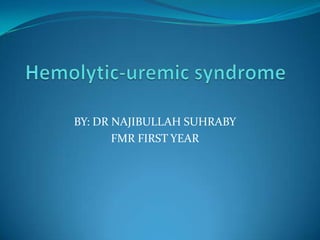
Hemolytic uremic syndrome
- 1. BY: DR NAJIBULLAH SUHRABY FMR FIRST YEAR
- 2. Definition HUS, is a disease characterized by : Hemolytic anemia Uremia Low platelet count It predominantly, but not exclusively, affects children.
- 3. Types HUS Typical HUS Atypical HUS HUS due to Complement abnormalities
- 4. CLASSIFICATION OF HUS / TTP ACCORDING TO ETIOPATHOGENESIS Type of HUS / TTP Specific Cause Infection related Shiga toxin producing E.coli/Shigella Pneumococcal infection HIV Typical Other viral or bacterial infections • Complement factor abnormality Factor H deficiency CTD Factor I deficiency • Miscellaneous Drugs Atypical Malignancy
- 5. ETIOPATHOGENESIS Typical/Diarrhea associated/Shiga Toxin associated HUS Enterohaemorrhagic E. coli Shigella dysenteriae type 1 Rarely, HUS can occur with E. coli UTI
- 7. CONTI.. The common serotype of E coli:0157:H7 However, only about 10-15% patients with E. coli 0157:H7 infection will develop HUS Sources of infection are : Milk and animal products (incompletely cooked beef, pork, poultry,lamb) Human feco-oral transmission Vegetables, salads and drinking water may be contaminated by bacteria shed in animal wastes
- 9. CAN THIS FEEDING TRANSMIT?
- 10. Atypical/Non-Diarrhea Related HUS Pneumococcal HUS HUS due to Complement abnormalities Miscellaneous Causes of HUS / TTP Abnormalities in intracellular vitamin B12 metabolism HIV Systemic lupus erythromatosus Malignancies Radiation Certain drugs
- 11. Other infections associated with HUS Include viruses like : Influenza Cytomegalovirus Infectious mononucleosis Bacteria like: Streptococcii Salmonella
- 12. CONTI… The typical pathophysiology involves the shiga-toxin binding to proteins on the surface of glomerular endothelium and inactivating a metalloproteinase called ADAMTS13, which is also involved in the closely related TTP
- 13. CONTI.. The arterioles and capillaries of the body become obstructed by the resulting complexes of activated platelets which have adhered to endothelium via large multimeric vWF. The growing thrombi lodged in smaller vessels destroy RBCs as they squeeze through the narrowed blood vessels, forming schistocytes, or fragments of sheared RBCs.
- 14. CONTI… The consumption of platelets as they adhere to the thrombi lodged in the small vessels typically leads to mild or moderate thrombocytopaenia However, in comparison to TTP, the kidneys tend to be more severely affected in HUS, and the central nervous system is less commonly affected
- 15. CLINICAL FEATURES The commonest clinical presentation of HUS is : Acute pallor Oliguria Diarrhea or dysentery It occurs commonly in children between 1-5 years of age HUS develops about 5-10 days after onset of diarrhea
- 16. CONTI.. Hematuria and hypertension are common. Complications of fluid overload may present with: Pulmonary edema Hypertensive encephalopathy Despite thrombocytopenia, bleeding manifestations are rare Neurological symptoms like: Irritability Encephalopathy Seizures
- 17. INVESTIGATIONS CBC Peripheral blood smears Reticulocyte count LDH Bili unconjigated Cr & BUN Urine analysis Hemoglobinuria Hematuria Proteinuria
- 18. Schistocytes
- 19. Investigations to Identify Cause In patients with dirrhea, the identification of pathogenic EHEC or Shigella is performed by: Stool culture Further serotyping by agglutination or enzyme immunoassay Rarely HUS can occur with E. coli UTI: Urine cultures are indicated in non-diarrheal patients
- 20. Conti.. Bacteriological cultures of body fluids are indicated in suspected pneumococcal disease. Sputum CSF Blood Pus
- 21. Diagnosis Clinically, HUS can be very hard to distinguish from TTP The laboratory features are almost identical, and not every case of HUS is preceded by diarrhea HUS is characterized by the triad of: Hemolytic anemia Thrombocytopenia Acute renal failure
- 22. Cont… The only distinguishing feature is that in TTP fever and neurological symptoms are often present, but this is not always the case A pericardial friction rub can also sometimes be heard on auscultation The two conditions are sometimes treated as a single entity called TTP/HUS.
- 23. MANAGEMENT Supportive Therapy Antibiotics Plasma Therapy Miscellaneous
- 24. Supportive Therapy In all patients, supportive treatment is primary. Close clinical monitoring of : Fluid status Blood pressure Neurological Ventilatory parameters Blood levels of glucose, electrolytes, creatinine and hemogram need frequent monitoring
- 25. CONTI.. The use of antimotility therapy for diarrhea has been associated with a higher risk of developing HUS With the onset of acute renal failure : Fluid restriction Diuretics
- 26. Antibiotics E. coli Shigellosis pneumococcal HUS
- 27. Plasma Therapy In aHUS due to : complement factor abnormality ADAMTS13 deficiency The replacement of the deficient factor with FFP Daily plasma infusions (10 to 20 mL/kg/day) Exchange of 1.5 times plasma volume ( 60 to 75 mL/kg/day) using FFP
- 28. Miscellaneous In infants with HUS associated with cobalamin abnormalities: Treatment with hydroxycobalamin Oral betaine Folic acid Normalizes the metabolic abnormalities can help to prevent further episodes.
- 29. CONTI.. In patients with persistent ADAMTS13 antibodies and poor response to plasma exchange: Immunosuppressive therapy with high dose steroids/cyclophosphamide/ cyclosporin/rituximab Splenectomy
- 30. Prognosis With aggressive treatment, more than 90% survive the acute phase. About 9% may develop end stage renal disease. About one-third of persons with HUS have abnormal kidney function many years later, and a few require long- term dialysis. Another 8% of persons with HUS have other lifelong complications, such as : High blood pressure Seizures Blindness Paralysis
- 32. KEY MESSAGES Good sanitation and maintenance of food hygiene can prevent diarrhea associated HUS. Supportive care with early dialysis support remains the cornerstone of management. Non-infective atypical HUS should be treated rapidly with plasma therapy. Efforts should be made to make an etiological diagnosis in cases of atypical HUS as treatment and prognosis is affected.
